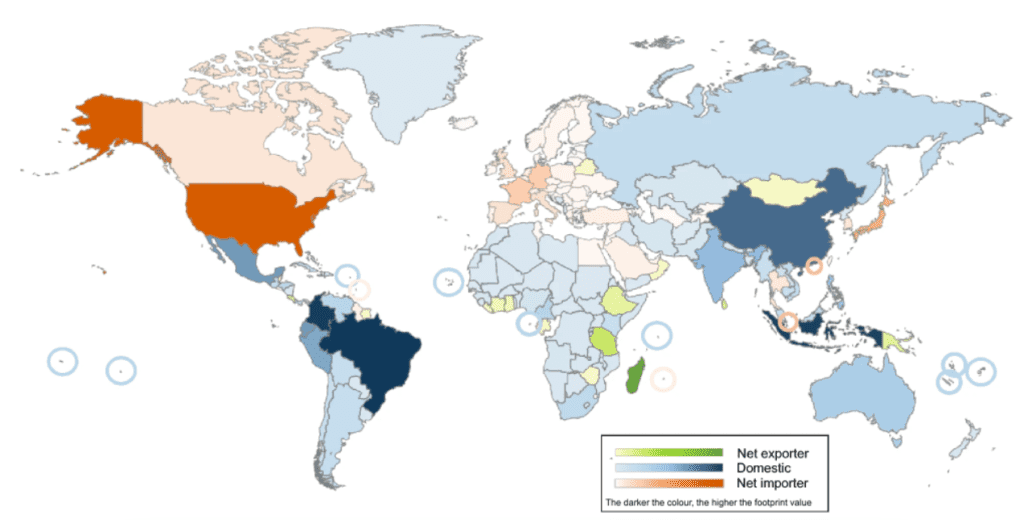Biodiversity under grave threat in many parts of the world, with over one million species already facing extinction, and projections generally look dire. Human activity is the main driver of this loss, often driven by the consumption of products and services in rich countries far away from poorer ones where the species live, a new study found.

Researchers looked at 5,000 species in 188 countries and found consumption in North America, Europe, and East Asia, finding that consumption in rich countries is driving species extinction far away from home. Species like Malagasy giant Rat in Madagascar (Hypogeomys antimena) and the Nombre de Dios Streamside Frog (Craugastor fecundus) are threatened by actions taken by humans thousands of miles away.
“The complexity of economic interactions in our globalized world means that the purchase of a coffee in Sydney may contribute to biodiversity loss in Honduras. The choices we make every day have an impact on the natural world, even if we don’t see this impact,” Amanda Irwin, lead researcher in the study, said in a statement.
Consumption and biodiversity
Using data available in the Rest List of Threatened Species from IUCN, Irwin and her team calculated domestic, exported, and imported extinction-risk footprints. Of the 188 countries reviewed for the study, they identified a group of 76 countries as net importers of extinction risk – with their consumption driving species to extinction somewhere else.
Meanwhile, in sixteen other countries, concentrated in Africa, this extinction-risk footprint is driven by offshore consumption. Madagascar’s domestic consumption, for example, drives only 34% of its territorial extinction-risk footprint. The rest is linked to consumption in other countries, especially the US (14%), France (11%), and Germany (6%).

The researchers also found that international trade drives almost 30% of the global extinction-risk footprint. This agrees with previous studies, which found trade was implicated in between one quarter and one-third of all species-driven biodiversity loss. Indonesia, for example, exports more extinction-risk footprint than it imports.
The food and beverage sector was found to be the largest driver of consumption-induced extinction risk globally, generating 20% of the global extinction-risk footprint, followed by the agriculture (19%) and construction (16%) sectors. Previous studies have also identified food consumption and agriculture activities as drivers of biodiversity loss.
“The finding that about 30% of the global extinction-risk footprint is embedded in international trade underlines the need to consider the responsibilities of different countries and all actors, including financing of conservation, not only in the context of their national boundaries but extending to their impacts internationally,” co-author Juha Siikamäki said in a statement.
The researchers also applied their analysis at a species level. In western Africa, for example, 44% of the extinction-risk footprint for the Western Gorilla (Gorilla gorilla) is exported. The US also imports 24% of the extinction-risk footprint of the Nombre de Dios Streamside Frog, with 3% of its footprint due to consumption of US-based tobacco, coffee, and tea.
They also found differences in the taxonomic make-up of country extinction-risk footprints. Most of Colombia’s territorial footprint (60%), for example, is generated by threats to amphibians, while threats to birds make up most (59%) of Brazil’s footprint. In Papua New Guinea, the main extinction risk export is mammals (65%), the study showed.
“The activities which threaten species in a given location are often induced by consumption patterns in far-away locations, meaning that local interventions may be insufficient,” co-author Arne Geschke said in a statement.
A global biodiversity crisis with no plan
Governments are currently negotiating a new global agreement to reverse the loss of wildlife and habitats. However, progress has been slow so far. The new framework should be agreed on later this year at a biodiversity summit in China (COP15). For campaigners, this should be considered as important as the Paris climate agreement of 2015.
Much of the agreement’s draft text is currently plagued with brackets (meaning it remains unresolved) — a sign of divergent opinions on the focus of the goals and targets, the level of ambition needed, and the resources needed to deliver on them. Developing countries are asking rich ones for funding to protect the natural resources everybody relies on.
“The biodiversity and climate crises are occurring in parallel,” Irwin said in a statement. “The upcoming COP-15 will hopefully raise the profile of the other human-driven natural crisis of our generation – irreparable biodiversity loss – and our findings can provide valuable insights into the role that global consumption plays as one of the drivers of this loss.”
The study was published in the journal Scientific Reports.






